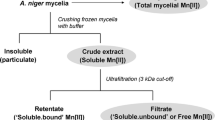Abstract
Effect of carbon, nitrogen, and metal ion sources on superoxide dismutase (SOD), catalase (CAT) activities, and lipid perioxide (LPO) levels in Cordyceps militaris mycelium were investigated at stationary growth phase by step supplementing with these nutrition factors in shake-flask cultures. Mycelium was cultivated in several growth media containing different carbon sources. The observed highest SOD and CAT activities were 44.3 U/mg protein in the presence of 20% potato broth plus 2% glucose medium and 93.7 U/mg protein in presence of 20% potato broth plus 1% glucose medium, respectively. By supplementing with either yeast extract or tryptone in 0.1–0.5% concentration range, the highest SOD and CAT activities were 21.1 U/mg protein in medium supplemented with 0.1% yeast extract and 20.7 U/mg protein in medium supplemented with 0.1% tryptone, respectively. Supplementing with Cu2+, Zn2+, and Mn2+ caused a stimulation of SOD synthesis. The minimum LPO level was observed at media presented Zn2+. The time course of SOD and CAT biosynthesis showed two maxima, which correspond to the maximum of biomass. High SOD levels and low LPO levels in the medium described above indicated that the appropriate metal ions could provide a suitable protection for cells against oxygen radical damage.

Similar content being viewed by others
Literature Cited
Ahn YJ, Park SJ, Lee SG, Shin SC, Choi DH (2000) Cordycepin: selective growth inhibitor derived from liquid culture of Cordyceps militaris against Clostridium spp. J Agricult Food Chem 48:2744–2748
Alicja S (1998) Towards an integrated management of Dendrolimus pini L. Proceedings: Population dynamics, impacts, and integrated management of forest defoliation insects; USDA forest service general technical report NE-247:129–142
Ayar-Kayali H, Ozer N, Tarhan L (2002) Intracellular superoxide dismutase, catalase, and glutathione peroxidase activities and membrane lipid peroxide levels in Fusarium acuminatum upon environmental changes in a defined medium. Arch Biochem Biophys 400:265–272
Bergmeyer HU (1974) Methods of enzymatic analysis. New York: Academic Press, pp 357–458
Bradford MM (1976) Rapid and sensitive method for the quantitation of microgram quantities of protein utilizing the principle of protein-dye binding. Anal Biochem 72:248–254
Buege JA, Aust SD (1978) Microsomal lipid peroxidation. Methods Enzymol 52:302–310
Chang H L, Chao GR, Chen CC, Mau JL (2001) Non-volatile taste components of Agaricus blazei, Antrodia camphorata and Cordyceps militaris mycelia. Food Chem 74:203–207
Clarkson JM, Charnley AK (1996) New insights into the mechanisms of fungal pathogenesis in insects. Trends Microbiol 4:197–203
Dolashka-Angelova P, Stevanovic S, Dolashki A, Angelova M, Serkedjieva J, Krumova E, Pashova S, Zacharieva S, Voelter W (2004) Structural and functional analysis of glycosylated Cu/Zn-containing superoxide dismutase from the fungal strain Humicola lutea 103. Biochem Biophys Res Commun 317:1006–1016
Eickhoff J, Potts E, Valtos J, Niederhoffer EC (1995) Heavy metal effects on Proteus mirabilis superoxide dismutase production. FEMS Microbiol Lett 132:271–275
Farr SB, Kogoma T (1991) Oxidative stress responses in Escherichia coli and Salmonella typhimurium. Microbiol Rev 55:561–568
Fridovich I (1986) Biological effect of the superoxide radical. Arch Biochem Biophys 247:1–11
Gast CH, Jansen E, Bierling J, Haanstra L (1988) Heavy metals in mushrooms and their relationship with soil characteristics. Chemosphere 17:789–799
Gonzales-Fledna B, Demple B (1995) Metabolic sources of hydrogen peroxide in aerobically growing Escherichia col. J Biol Chem 270:13681–13687
Harald O, Ivo Z, Michelle S, Hubertus H (2000) Iron starvation to increased expression of Cu, Zn-superoxide dismutase in Aspergillus. FEBS Lett 485:113–116
Hengge-Aronis R, Lange R, Henneberg N, Fischer D (1993) Osmotic regulation of rpoS -dependent genes in Escherichia coli. J Bacteriol 175: 259–265
Hsu TH, Shiao LH, Hsieh Ch, Chang DM (2002) A comparison of the chemical composition and bioactive ingredients of the Chinese medicinal mushroom dongchongxiacao, its counterfeit and mimic, and fermented mycelium of Cordyceps sinensis. Food Chem 78:463–469
Kelly RL, Reddy CA (1986) Purification and characterization of glucose oxidase from ligninolytic cultures of Phanerochaete chrysosporium. J Bacteriol 166:269–274
Latiff LA, Daran ABM, Mohamed AB (1996) Relative distribution of minerals in the pileus and stalk of some selected edible mushrooms. Food Chem 56:115–121
Li SP, Su ZR, Dong TT (2002) The fruiting body and its caterpillar host of Cordyceps sinensis show close resemblance in main constituents and anti-oxidation activity. Phytomedicine 9: 319–324
Liu S, Oeljeklaus S, Gerhardt B, Tudzynski B (1998) Purification and characterization of glucose oxidase of Botrytis cinerea. Physiol Mol Plant Pathol 53:123–132
Marklund S, Marklund G (1974) Involvement of the superoxide anion radical in the autooxidation of pyrogallol and a convenient assay for superoxide dismutase. Eur J Biochem 47:248–254
Mayer AM, Staples RC, Gil-ad NL (2001) Mechanisms of survival of necrotrophic fungal plant pathogens in hosts expressing the hypersensitive response. Phytochemixtry 58:33–41
McCord JM, Fridovich I (1969) Superoxide dismutase, an enzymic function for erythrocuprein (hemocuprein). J Biol Chem 244:6049–6055
Song CH, Jeon YJ, Yang BK, Ra KS, Sung JM (1998) Anti-complementary activity of exo-polymers produced from submerged mycelial cultures of higher fungi with particular reference to Cordyceps militaris. J Microbiol Biotechnol 8:536–539
Wang P, Schellhorn NE (1995) Introduction of resistances to hydrogen peroxide and radiation in Deinococcus radiodurans. Can J Microbiol 41 170–176
Wang ZS, He ZJ, Li SX, Yuan QS (2005) Purification and partial characterization of Cu, Zn containing superoxide dismutase from entomogenous fungal species cordyceps militaris. Enzyme Microbial Technol 36:862–869
Westerbeek-Marres CAM, Moor MM, Auto AP (1998) Regulation of manganese superoxide dismutase in Saccharomyces cerevisiae. The role of respiratory chain activity. Eur J Biochem 174:611–620
Zhang XK, Liu WX (1997) The test of chemical constituents of Cordyceps militaris. Mycosystema 16:78–80
Author information
Authors and Affiliations
Corresponding author
Rights and permissions
About this article
Cite this article
Wang, Zs., Gu, Yx. & Yuan, Qs. Effect of Nutrition Factors on the Synthesis of Superoxide Dismutase, Catalase, and Membrane Lipid Peroxide Levels in Cordyceps militaris Mycelium. Curr Microbiol 52, 74–79 (2006). https://doi.org/10.1007/s00284-005-0193-9
Received:
Accepted:
Published:
Issue Date:
DOI: https://doi.org/10.1007/s00284-005-0193-9




